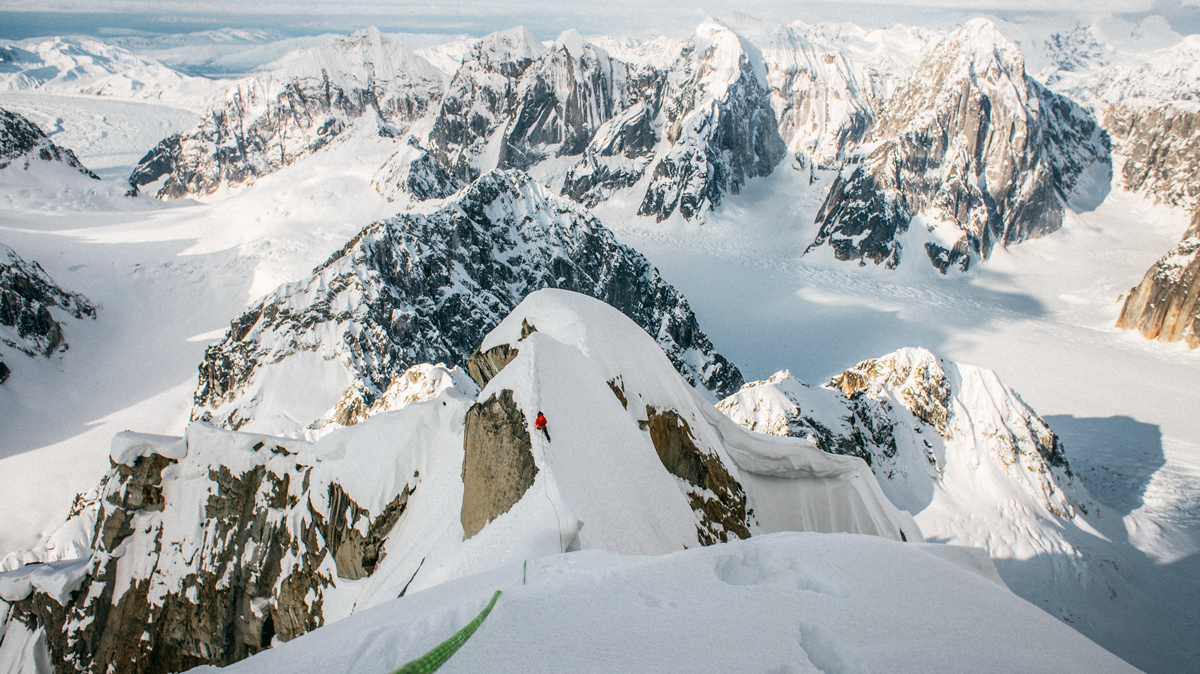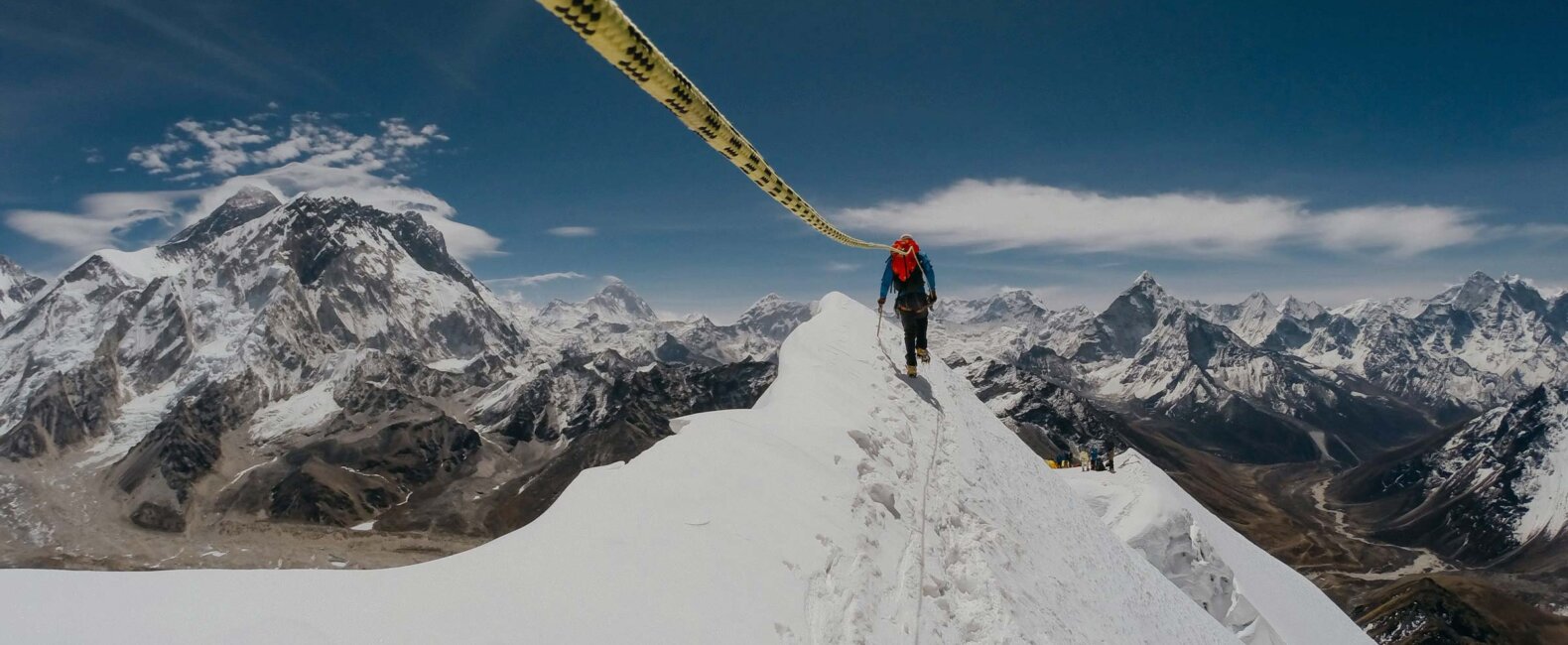Now that the playing field is level, what puts one filmmaker ahead of another? For Renan Ozturk, a veteran expedition filmmaker, the answer is simple: suffering. “You get maybe five [magic moments] in your life,” Renan told us. “You have to suffer a little more for them, put yourself out there a little more…”
For Renan, “suffer a little more” has meant hauling his gear to the edge of Mount Everest to catch the sunrise, smashing open his skull while trying to get the perfect shot, and positioning his camera — and himself — beneath a free-falling car. But as crazy as his antics may seem, they’re working. Renan’s films have received international attention, acclaim, and awards. And when you watch them, his hard work and suffering are apparent: they’ve alchemized into something magical.
We recently talked with Renan about his life, his methods, his aptitude for suffering, and the things he’s found in Trader Joe’s dumpsters.

Did you start off as an adventurer or a filmmaker?
I started off as more of an adventurer. I studied science in school, but the very last class I took happened to be an art class. After I finished school, I gave away all of my belongings and had some friends drop me off in the desert. I wanted to climb in National Parks and travel around the Desert Southwest. Yosemite, Joshua Tree, Zion National Park — these places had a big impact on me. So I started climbing and doing artwork inspired by that art class I’d taken.
I was hitching rides, meeting the climbing community, and I quickly realized climbing was about more than just this physical pursuit. There was this group of people doing this, like, endless summer thing — but with climbing. They were traveling around, living the good life, dumpster diving in Trader Joe’s dumpsters for food, developing art, and climbing side by side.
After doing this for a while, I got some media attention for a ropeless climb I did that ended up in a climbing film called Return to Sender. That led to my getting sponsorships from bigger brands like The North Face, which led to my going on bigger expeditions. At this point, camera technology had gotten better, and you could shoot something cinematic with something small enough to take along on one of these adventures. So I started shooting, and then I went full into it.
Is there good stuff in Trader Joe’s dumpsters?
Oh yeah. Some of the best times of my life were in Joshua Tree. We’d go down into Palm Springs to the Trader Joe’s dumpsters and find perfectly good food. They really overpackage certain food, so it’s not sketchy at all. We’d bring back a vanload and feed an entire camp — a big potluck — everything from organic salmon to unopened organic coffee, endless bread and eggs, basically the whole store. It was all right there.

How did you learn filmmaking?
I mostly taught myself. A lot of these adventures we did weren’t big commercial productions, but we were trying to make them look like they were. It usually comes down to very specific gear. Solar panels when you don’t have access to power. Special chargers. Special batteries. That first year we were a little bit ahead of the curve. We got one of the first 5Ds and we took it to the mountains. We were uploading HD video on a satellite modem, telling the story as it happened, which was actually pretty mundane.
Do you enjoy climbing more when you’re documenting or not documenting?
I prefer to document. I’ve been doing it for so long, it’s just a part of it for me. There’s no real separation. Which doesn’t mean it’s not frustrating to see everyone else on the trip relaxing while you’re staying up late and waking up early.

How much planning do you do ahead of time?
We do as much as we can. We usually know what the key character themes are going to be. Maybe there’s an older, wiser person on the trip and some youngster. Those are threads to pick up on and follow. But for the most part, you have to approach it like a true documentary project. You have to shoot everything because you don’t know when something will happen that’s going to be really telling. Adventures aren’t scripted. The most interesting parts are when they go awry, which makes things hard.
People who normally shoot commercials get really frustrated because there’s no script. You never put the camera down. You end up not using 90 percent of what you shoot, but maybe that extra little time-lapse you took ends up making it into the edit. You just don’t know.
Have you ended up in dangerous situations?
Yeah, definitely. The film we did called Meru, which won the Audience Award at Sundance, that was a particularly dangerous one. I almost died on one of our first expeditions. I crushed my skull, broke two vertebrate, severed an artery that cut off half the blood to my brain, which was a pretty close call. That was all while shooting that project.
I tend to scare people though. We did a commercial shoot once where we rolled a car off a cliff. Everyone was picking their shooting locations, and I picked the one right underneath the car. I wanted to get a shot of it coming toward me, and I was going to jump out of the way at the last minute. But the car took a wrong bounce on the way down, and for a second it looked like it was going to hit me. Everyone freaked out. It ended up being fine. Unfortunately, taking risks is how you get the interesting angles. You have to push things a little bit further.
I crushed my skull, broke two vertebrate, severed an artery that cut off half the blood to my brain, which was a pretty close call.

Is it purely your interest in getting good shots that puts you in danger, or do you enjoy danger for its own sake?
For me, it’s about the story and the shot and the overall vision, rather than just the adventure. Some of these shots require suffering. You have to put your body in awkward positions. You have to hang off the side of the car. You have to wrench your back. Like on the film I worked on recently called Sherpa, which is about the Sherpa perspective on Everest. I was driven to get this shot on the ridge of Everest at sunrise. So I put myself in harm’s way by carrying the RED camera and all of these specially made battery packs to this ridge because I thought capturing the sunrise on the roof of the world would be something worth suffering for.
Do you think suffering has paid off?
For sure. Like I was saying before, those are the moments that make all the difference. You get maybe five of those in your life. You have to suffer a little more for them, put yourself out there a little more — but then you have a higher chance of catching those magic moments. Some of filmmaking is just luck. You have to be the one who is trying harder and putting yourself out there. Everyone has the same cameras now. The field has kind of leveled. But it takes a little more work to get those special moments.
Everyone can buy the same camera, but not everyone is willing to suffer as much for a shot. It’s what makes the difference.
Still, I’m curious about what gear you use on these expeditions. What’s your go-to kit?
My current lightweight expedition kit usually includes a RED Dragon with a Canon mount and a bunch of lightweight Zeiss prime lenses. I also have a Sony A7s for when the climbing is too difficult to bring the RED. I bring an Atomos Shogun 4K Recorder for the Sony camera. I bring a lightweight slider, a MŌVI or a Ronin, a small drone, a tripod, a solar kit, a Yeti 400 battery, a few solar panels, and maybe a Sherpa 100 lithium small battery. Every trip is a little different, but that’s more or less the essential kit.

Everyone can buy the same camera, but not everyone is willing to suffer as much for a shot.
You’ve been doing this work for a while now. How do you feel like you’ve improved?
One of the main things is learning that it’s not just about the visuals. You have to focus on storytelling, not just creating visual porn — that’s really the most important thing. I’ve learned to let moments breathe. I’ve learned to recognize which stories are worth telling, which characters are good characters. I’ve learned how to conduct myself in an interview, how to let the subject have time to say the things you’d normally rush through. Those are the things that come with experience.

If you’re wondering how to make your work stand out against the hoard of other filmmakers’, maybe try Renan’s advice: Suffer more than they do. Get up before the sunrise, put yourself in uncomfortable positions, stand underneath falling cars. Your work will only improve when you’re willing to work for it. Besides, nobody said filmmaking was going to be safe.
Photos courtesy of Renan Ozturk, Kris Erickson and Freddie Wilkinson.

















































































